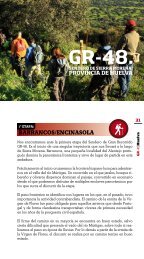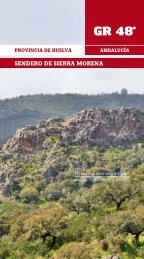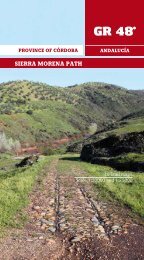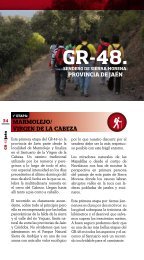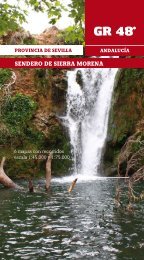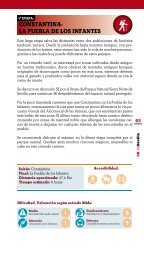SIERRA MORENA PATH - GR-48: Sendero de Sierra Morena
SIERRA MORENA PATH - GR-48: Sendero de Sierra Morena
SIERRA MORENA PATH - GR-48: Sendero de Sierra Morena
- No tags were found...
Create successful ePaper yourself
Turn your PDF publications into a flip-book with our unique Google optimized e-Paper software.
ROUTE GENERAL DESCRIPTIONThis stage starts at the Paseo <strong>de</strong>l Moro Street which is lto the south of the towncentre. Walkers can easily get to this street by taking the second exit at theroundabout on the road to Seville and heading towards the town centre.Cazalla <strong>de</strong> la <strong>Sierra</strong> holds the second larger population in the region. The townis head of the administrative area although it shares administrative functionswith the other main towns.First settlers in the area were those primitive hunters living in the Stone Ageas many remains of chipped stone implements from the Palaeolithic periodhave been found in the nearby Cuevas <strong>de</strong> Santiago Cave. However, it is in theNeolithic period when the area was permanently occupied by large groups ofsettlers. Many utensils from that period such jars, knives and even axes haveeven been found in the town centre.56<strong>GR</strong>-<strong>48</strong>SevillaThe Carthaginians were interested on the metals of the region and, later theRomans will improve the standards of their villages by using the many mineralresources in the area. Nevertheless, it is in the middle ages when Cazalla <strong>de</strong>la <strong>Sierra</strong> is shaped into a proper town. The Fortress of almoha<strong>de</strong> plant and theArrabal <strong>de</strong> Azahín suburb are two clear references of that period. This stageof the route will eventually pass by the old houses that give character to themedieval suburbGar<strong>de</strong>ns at the Arroyo <strong>de</strong> la Vega Brook surroundingsOn having left behind a public park, we will pass by the bullfighting arena tocontinue ahead while ascending a <strong>de</strong>nsely woo<strong>de</strong>d avenue which goes upto the back of Nuestra Señora <strong>de</strong> la Consolación Church from the 14th and 15thcenturies. As the walk progresses between whitewash houses, some of themincrusted in outcropping bedrock, we will get to the Chorrillo, a round shapedwater trough and fountain where hikers may get some fresh water before leavingthe town.The trail will cross over a small bridge to go on the path known as Camino<strong>de</strong>l Valle or <strong>Sen<strong>de</strong>ro</strong> <strong>de</strong> las La<strong>de</strong>ras. The first section of this stage of the routematches this traditional path. A breathtaking view of the town remains at thehikers’ backs.57<strong>GR</strong>-<strong>48</strong>SevillaWhitewashed houses built on the bedrockAs the town fa<strong>de</strong>s off, the curves of the path will increasingly gui<strong>de</strong> us throughan area covered by gar<strong>de</strong>ns while approaching a valley. The valley restoresthe peace and the only noise that can be heard is that one from the patient gar<strong>de</strong>nerswho ten<strong>de</strong>rly are looking after their grateful piece of land. To the right isthe Arroyo <strong>de</strong> la Vega Brook watering the productive land and some spatteringCountry Houses which appear to be looking for tranquillity and at the sametime they receive some kind of protection from the nearby town.A former roun<strong>de</strong>d threshing floor stands out in the valley. Probably, this wasvery much threshed in the past to separate the wheat seeds from the straw andso provi<strong>de</strong> flour for the town. This job used to be done with the ‘trillo’ whichis a threshing-board pulled by horses or mules. The time of the year when thiswork was done is highlighted in a popular proverb. As the saying goes: ‘CuandoJunio llega, afila la hoz y limpia la era’, which means ‘When June comes, dosharp the sickle and clear the threshing floor’.




